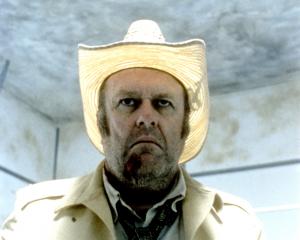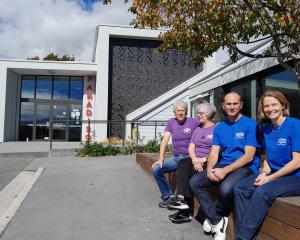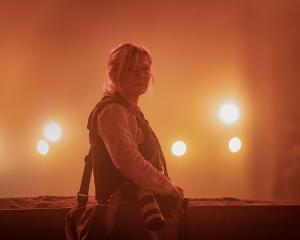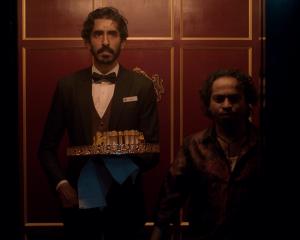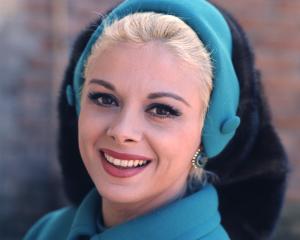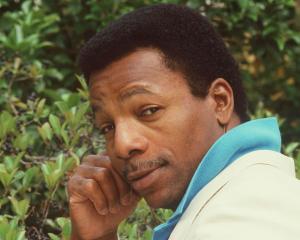It will be 50 years ago next week that director David Lean's epic film Lawrence of Arabia was given its royal premiere in London. Greg Dixon looks back on the making of a film Steven Spielberg calls a miracle.
"The desert shimmers and flickers in the heat. At a broken-down well in the middle of nowhere, a British soldier in desert uniform lies on the sand, fiddling lazily with his army compass and whistling idly.
At the well, Tafas, his Bedouin guide, throws a skin attached to a rope down into the water, making a splash that in the desolate, dazzling emptiness of the desert sounds like a rifle shot - a prescient echo of what is about to happen.
In the heat-blasted distance, just at the edge of sight, a small black speck appears. Tafas freezes; the soldier leaps to his feet. Is it a mirage?In the long seconds - it might only be a minute or two but feels like an hour - the black speck, making a peculiar swishing sound, grows slowly until at last the soldier and his guide - and we the audience - understand.
''Bedu!'' shouts Tafas, and runs for his gun. There is a crack, a real shot this time, and Tafas falls dead. The speck, the owner of the well, rides his camel forward, his rifle raised ..."
I'll let you pick yours. But in a film rich with superbly shot scenes the entrance of Sherif Ali - played by a brooding, impossibly handsome Omar Sharif in his first Western film - has to be my favourite scene in Lawrence of Arabia.
This is a scene that, for me, sums up what makes director David Lean's near-flawless 1962 film still so utterly compelling, even 50 years after its premiere and even in the age of modern uber-epics. This is a scene that revels in the bleak beauty of its setting, is utterly languid in its pacing, is beautifully composed and shot, turns your knuckles tight with the tension and has been achieved without any kind of film-making jiggery-pokery whatsoever - or so I thought.
It turns out it had been ever-so-carefully designed. In his definitive 1996 biography of Lean, author Kevin Brownlow reports that Ali's ride towards the camera, which ran for nearly 10 minutes of unedited film, was made ''more interesting'' by Lean's art director John Box, who ''painted a white line, a camel track coming to the well''. Black pebbles were placed on another line.
''[Before that] there was something bland about the shot,'' Box said.
''What are we going to do? You're going to paint the desert with these fingers, which point toward where the man is coming from.''
At the end of shooting this sequence Lean is said to have told Box: ''You'll never do a better bit of designing in films, ever!''
As in all Lean's work - which includes classics Doctor Zhivago and Bridge Over The River Kwai - nothing in the making of Lawrence was left to chance, even though it was a mammoth, larger-than-life production involving the proverbial cast of thousands working across continents. And it took forever to film. The first official day of the shoot was May 15, 1961, the climax of nearly two years' preparation work. The shoot didn't end until October 1962.
Indeed, the making of Lawrence of Arabia - released in a new high-definition version on Blu-ray this month - was epic film-making of the most old-fashioned kind.
Unlike modern film-makers, who create whole scenes and cities on super-computers, Lean's Lawrence involved blokes building stuff for real. And then blowing it up, for real.
The Red Sea port city of Aqaba, which Lawrence and an Arab army invade after crossing the Nafud desert, was actually built in replica by Box and his team in a dry riverbed in Spain. Using a photo of the town in 1917, 300 fake buildings were erected. And, when you watch this scene again, you can only appreciate the sheer and glorious madness involved in doing such a thing.
The memorable charge into the replica Aqaba by Peter O'Toole's Lawrence, Sherif Ali and the army of Auda abu Tayi (Anthony Quinn in an amazing fake nose) is said to have employed more than 450 horses and 150 camels.
However, it is the scenes shot in Jordan which astound, not only for the exquisiteness - the sequences with Lawrence and Tafas riding to meet Prince Faisal, and the Arab camp at Wadi Rum, are gobsmackingly wonderful to look at - because they seem to have been unbelievably tough to make.
Cameras and camels had to be hauled up giant sand dunes, which also had to be carefully groomed; plastic drinking cups were banned from the set after the wind kept blowing them across the dunes and into shot. There were cost blowouts, too (which forced the shoot to move to Spain), and much illness among the vast cast and crew. And then there was the desert heat.
In his biography, Brownlow quotes the production's head of publicity, John Woolfenden, writing: ''Although the summer has scarcely started at [Jordan's] Jebel Tubeiq, the heat radiates like the proverbial blast furnace from the desert floor to a height of a thousand feet. Cast and crew wear goggles, for not only does the dazzling colour hurt their eyes after a prolonged gaze, but also the sand itself, blown by the `hamsin' or desert wind, stings like birdshot.''
These were real men making a real movie.
But, of course, Lawrence of Arabia is a quite literally a bloke's movie.
In a move unthinkable to modern directors such as Peter Jackson, there are no speaking parts for women in Lawrence. Indeed, by reputation it is the longest film (at 218 minutes) made in which a woman doesn't speak (though Arab women are heard trilling as they farewell their men from Wadi Rum before the battle of Aqaba).
And it seems the blokes had quite a time, even if Lean allowed no tomfoolery on set. The stories are legend, some are possibly true, and alcohol and O'Toole, who until he played Lawrence was an unknown, seemed to be a common thread.
While filming in Jordan, O'Toole and Sharif would head for Beirut during the short monthly breaks in production.
''We'd drink without stopping for 48 hours,'' Sharif wrote in his '70s autobiography The Eternal Man.
''We went hunting girls in every bar, every nightclub''.
There is another story, possibly true, that during a rough-cut screening of the film, O'Toole spent his time trying to work out which scene was the one in which Sharif was suffering from the clap.
Even the Hollywood premiere wasn't safe from their larrikinism. O'Toole, Sharif and comedian Lenny Bruce were arrested the night before it. The cops had turned up just as Bruce was ''shooting up''.
''[Lawrence producer] Sam Spiegel got us out of jail,'' Sharif recently told Britain's Independent.
''He arrived with six lawyers. Of course we were completely terrified.''
It is a long film, the longest, in fact, to win the best picture Oscar. It is also one of the most successful, winning seven Academy Awards in total, four Baftas and five Golden Globes. It frequently appears in the top 10 of the world's greatest films and its style has been hugely influential.
It is, or at least it was, hugely controversial, too. T.E. Lawrence's brother, Professor A.W. Lawrence, who sold the rights to his brother's memoir Seven Pillars of Wisdom to Spiegel for a paltry $US25,000, was furious with screenwriter Robert Bolt's final script, which depicted Lawrence as a masochist and a sadist.
Biographers and historians have quibbled, too, over the portrayal of Lawrence, and the families of others depicted in the film were extremely upset upon the film's release.
However, 50 years on, all that is utterly irrelevant. As director Steven Spielberg said in an interview around the time Lawrence was first released on DVD in 2001, Lean's film is nothing short of a miracle.
Another view of Lean's achievement might be a line from Mr Dryden, the dry, playful, deeply cynical Arab Bureau official. After Lawrence and the Arabs take Aqaba, he says to General Allenby: ''Before he did it, sir, I'd have said it couldn't be done.''


